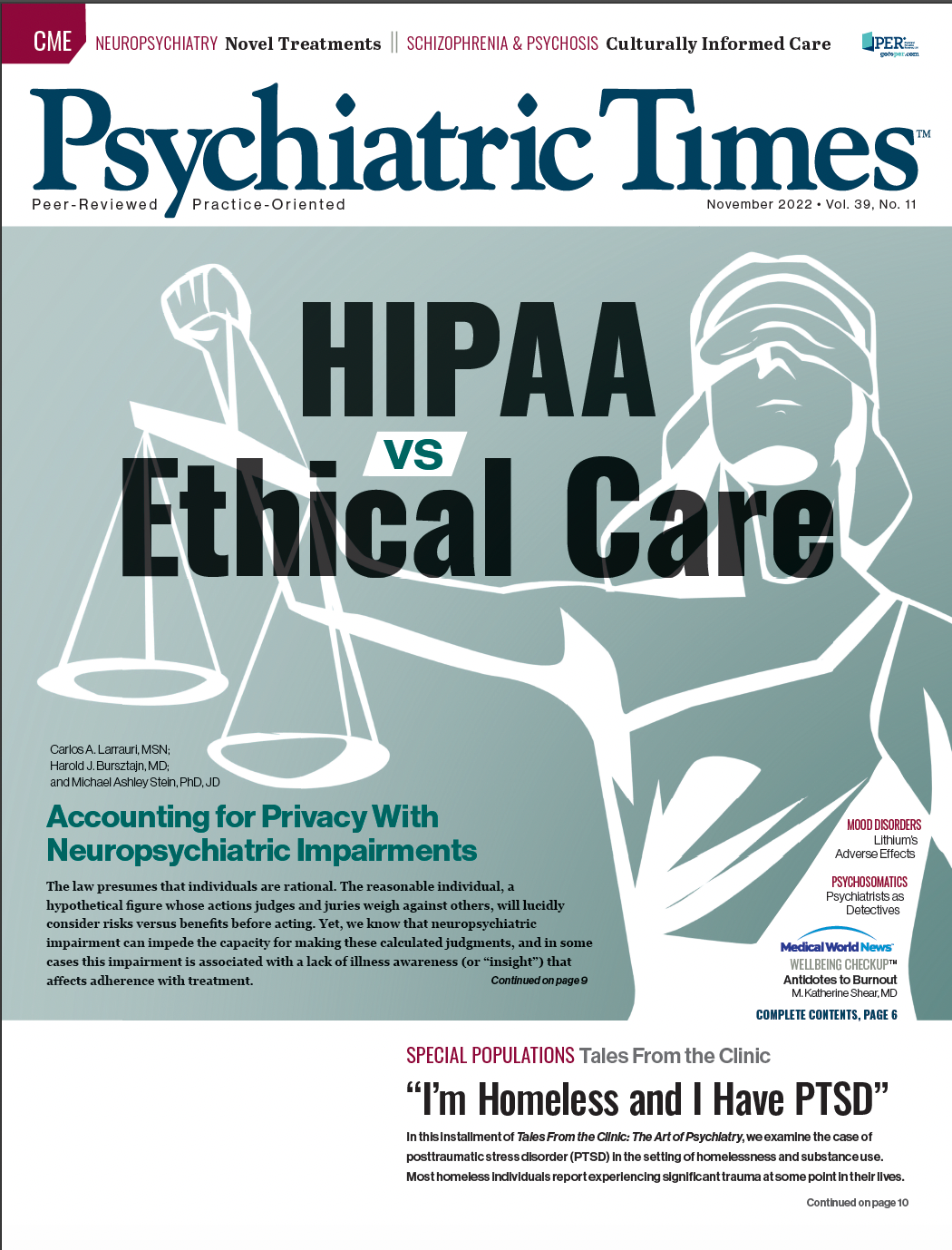Publication
Article
Psychiatric Times
Advances and Challenges in Adult ADHD
Author(s):
What are the advances in adult ADHD?
BillionPhotos.com/AdobeStock

PSYCHVIEW
Many advances have been made in the past 20 years in the field of adult attention-deficit/hyperactivity disorder (ADHD), explained Theresa Cerulli, MD, and Anthony L. Rostain, MD, MA, during a recent PsychView custom video program.
“The good news is that thanks to our efforts to educate both the public and health professionals about the fact that ADHD exists in adults, it has become more and more recognized by a growing number of people,” said Rostain, founding director of the Adult ADHD Treatment and Research Program and emeritus professor of psychiatry and pediatrics at Perelman School of Medicine at the University of Pennsylvania in Philadelphia. Nonetheless, Rostain and Cerulli, president and medical director of Cerulli & Associates in North Andover, Massachusetts, and lecturer and clinical supervisor at Harvard Medical School and Beth Israel Deaconess Medical Center in Boston, agreed there are still challenges in clinical practice, including biases and incomplete treatment response.
Recognizing and Addressing Biases and Barriers
Biases associated with the label of ADHD have caused barriers to care, according to Cerulli and Rostain. Rostain noted the mistrust among underserved communities that has resulted in undiagnosed cases. Unconscious bias may also sway clinicians’ judgments, mistaking ADHD for anxiety or depression.
Another possibility, Rostain said, “is mistaking social impairment associated with adult ADHD as narcissistic personality disorder or other Cluster B kinds of disorders when, in fact, the underlying self-regulation leads to people having trouble acting in a way that we would say is either socially appropriate or not mature enough for their age.”
Cerulli added, “The other bias I see—especially with adult ADHD—is that a lot of people won’t come in because they are afraid that people are just going to think they’re seeking substances,” which results in delayed diagnoses.
“The stigma around stimulants is probably still one of the biggest hurdles we have to face,” Rostain said. “You hear the story again and again.” He said that patients have told him, “I knew I had it as a young person, but my parents really weren’t willing to take me [to a doctor] because they didn’t want to have me start on a stimulant medication.”
Always looking for the positives, the pair agreed this presents an important opportunity for clinicians. “It is the job of psychiatrists and other mental health providers to say, ‘ADHD does not equal stimulants. ADHD is a condition; we need to understand it. It’s got a chronic and rather unremitting impact on functioning, and we need to approach it in a multiplicity of ways,’” Rostain said.
The Impact of Functional Impairment
Rostain and Cerulli agreed functional impairment plays a huge role in their patients’ lives. “I think that ADHD has become more and more impairing as our society evolves,” Rostain said. The impairment affects many aspects of patients’ lives—beyond work and school issues, Cerulli added.
“Most adults with ADHD have trouble with everything—from managing time, getting things done, and following directions,” Rostain explained. “There’s also the impulsivity side...managing emotions and being able to think before you speak or not just jump into a million different directions, but really being able to handle frustration, for example. And not getting into too many traffic accidents or getting speeding tickets.”
Managing personal and professional relationships can be troublesome too. Individuals with ADHD may be viewed as insensitive when they forget important appointments or interrupt people. “A lot of social rejection goes on,” Rostain noted. “It’s pretty obvious that as we look at data from national epidemiologic studies, the No. 1 comorbidity of adults with ADHD is social anxiety disorder. And that’s based a lot, I think, in having repeated experiences of social rejection or social failure.”
“It’s really challenging for patients,” Cerulli concurred. “Divorce rate is twice as high when one spouse has ADHD. I really hope that people walk away understanding that ADHD is a problem with regulating attention, self-regulating behavior, control of one’s thoughts in terms of organizing, planning, time management—it affects everything.”
All that adds up, said Rostain, and can lead to low self-esteem. “There is a chronic sense of being inadequate, ineffective, and in some other way, not meeting others’ expectations. This can lead to some unfortunate coping mechanisms—overreliance on alcohol or substances, a tendency to overcommit and not be able to really deliver, and feeling constantly stressed out.”
Psychoeducation and Shared Decision-Making
The first step of treatment is psychoeducation, the pair noted. This includes the patient and their partner and/or close family members and should help define expectations. As patients understand what their brains do well—and what they do not do well—it is important to help teach skills that can support the patient, like making environmental adjustments and schedules. They noted communication skills might also improve relationships, especially when conflicts emerge. Rostain summarized this notion: “Pills don’t teach skills.”
Cerulli and Rostain also advocate for shared decision-making. Cerulli tlks with patients about treatment and what’s important to the patient. She likes to give patients several options and sometimes shares the choices she might make for herself. “Shared decision-making empowers somebody who otherwise probably had low self-esteem... to pay attention to the details,” she said.
Rostain also uses shared decision-making to define goals, the methods for reaching those goals, and the time frame for achieving them. “There’s got to be a realistic sense that this is going to be a process and we’re embarking on it together. We’re going to try different things according to your priorities,” he explained. “The purpose of treatment is to help people function better. It’s not just to ‘reduce symptoms.’ It is improving the functioning in various domains of life. And that’s why it’s important to have it be a shared decision-making, real conversation.”
Cerulli agreed, noting DSM criteria and checklists only go so far, so it is crucial to find out what is important for each patient. “For some of them it’s, ‘I want to be able to have a conversation with my kids without getting mad—or with my partner.’ You know, for others, it’s, ‘I want to be able to get through my workday more effectively or more efficiently.’ For others, it’s, ‘Hey, I want to be able to sit down and read a book and enjoy it.’ There are different priorities for people.”
Weighing and Making Treatment Choices
Although stimulants have generally been the first line of treatment, there are a number of choices to consider, Rostain and Cerulli said. Stimulants can be effective, but they can also be abused and have negative connotations associated with them. Plus, they do not work around the clock, Rostain said, adding that nonstimulants have the advantage of working 24/7 and without abuse potential, but their efficacy data are not as strong. Unlike stimulants, for which you can take a “medication holiday,” nonstimulants must be taken every day. For adults with ADHD, Rostain tends to look at the longer-acting stimulant preparations because adults tend to have longer days. “The big change in our way of looking at stimulants over the past decade or so has really been to look at the data and say, ‘Yeah, we get better adherence and fewer problems when we prescribe the long-acting medication preparation,’” he said.
So how does one choose between the amphetamine and methylphenidate options? “I always say talk with your patient about the differences in the profile. Find out if they have been on the medication. Many of our adult patients were treated as kids and have some remembrances of what did or did not work, or if other family members have been more or less successful on methylphenidate versus amphetamine,” Rostain said. However, if you think a patient may not want more than one medication trial, he said it might be better to start with an amphetamine because there is a higher slightly higher effect size compared with methylphenidate. He cautioned there is a greater risk of adverse effects (eg, appetite suppression, insomnia, a feeling of unrest/jitteriness).
Cerulli agreed. “One question I ask, having learned secrets of my patients over the years,” she said, including that many patients have tried a sibling’s medication. “I will ask them with a wink and a nod if...they had experience with somebody else’s medication.”
In terms of abuse potential, Rostain share insights from colleagues in the substance abuse field. “Many have pointed out that the proper use of stimulants can actually reduce certain forms of substance use disorder,” he said. So instead of disregarding a medication type, it is important to ensure there is a comprehensive treatment plan in place and that the patient is monitored.
Next Steps to Consider When Improvement Stalls
Rostain recommends using a measurement (like the Adult ADHD Self-Report Scale) to measure goal progress. If using a stimulant and the highest safe dose has been tried and the patient remains symptomatic, Rostain tries an agent from the other stimulant class or considers augmentation with a nonstimulant. “I do think that we should follow the guidelines, when possible, but oftentimes patients may need a slightly higher daily dose—as long as they’re getting a benefit that’s impacting functioning,” he said.
Treatment failure, on the other hand, occurs when patients are not able to maintain the regimen because of adverse effects, Rostain explained. That is when “you have to sort of play around with both changing the timing of the medication and maybe changing the preparation and/or augmenting with a nonstimulant.”
In those cases, Rostain and Cerulli agreed it is important to discuss adverse effects with patients. Rostain asks patients, “What is getting in the way of taking the medication? How do you know what [adverse] effects are really bothering you so that we can address those? Because if they hate taking it, in the long run, it’s going to be tough for them to remain on the medication.”
Cerulli added that some previous adverse effects are not seen with newer medications, some of which indicated to patients the medicine was working. As a result, she has to remind patients that they should not feel medicated but, instead, should feel the cognitive effects.
She also noted that the US Food and Drug Administration recently approved combination product (Azstarys). containing 70% serdexmethylphenidate (a Schedule IV substance) and 30% dexmethylphenidate (a Schedule II substance), which she called a novel mechanism. The serdexmethylphenidate is inert, she explained, and does not get activated until it hits the lower gastrointestinal tract. This makes it difficult to abuse. Meanwhile, the immediate-release dexmethylphenidate allows for a good start to the patient’s day. “So if you look at the combination of the 2 together, your PK [pharmacokinetic] curve, meaning when the blood levels come up, is within 30 minutes of administering Azstarys, and that’s due to the immediate-release dexmethylphenidate....Then just as that is starting to come down, just even a little bit, you’ve got enough from the serdexmethylphenidate, the prodrug portion, to pick up right there,” she explained.
Cerulli has had the opportunity to prescribe the drug to some of her patients and has been pleased with the results. She started with patients who responded to extended-release dexmethylphenidate, but for whom the effects were not lasting long enough. Another patient was experiencing an increased heart rate; recognizing the smoother PK curve with the serdexmethylphenidate-dexmethylphenidate combination, Cerulli prescribed the new agent, hypothesizing the patient would have a different physiological outcome. “It’s been great,” she said. “I’m thankful to say that he has not had the heart rate increases, which is good….His feedback was he’s thrilled that it is lasting longer, and he’s got the efficacy he always had. And now he’s not dealing with the bump he was getting in terms of some heart rate increases previously.”
Nonmedication interventions are also emerging, Rostain noted. “Trigeminal nerve stimulation, for example, has been approved,” he said. “There [are] some interesting data using certain video games that are helpful with improving working memory and reducing ADHD symptoms. I think we’re going to see a lot more attention being paid to nonmedical interventions.” He added there is also interest in other technology-based treatments, including virtual reality and transcranial magnetic stimulation.
“One hypothesis [of the underlying pathophysiology of ADHD] that’s quite attractive is that the default-mode network is overactive and not able to be suppressed sufficiently when executive control systems are operating,” Rostain said. “So in a way you’re competing with 2 different circuits in the brain, [so] perhaps using some of these other approaches will pay off. It will help individuals be able to switch better between executive attentional control and have less distraction from that default mode.”
Concluding Thoughts
Rostain said the take-home message is that there is a lot of hope and new approaches for treating adults with ADHD. “But most of all, it is important to integrate the medical with other intervention approaches in helping people cope better, helping them manage time better, and helping them learn how to develop skills that may be underdeveloped while reducing the kinds of negative coping mechanisms that people often rely on,” he said.
Cerulli agreed. “There have been so many advances since I started in the field 20 years ago. So many advancements,” she said. “Really, it’s so rewarding—we can really make a difference.”
To watch this PsychView program, visit psychiatrictimes.com/
psych-view/novel-delivery-systems-utilized-in-the-treatment-of-adult-adhd






